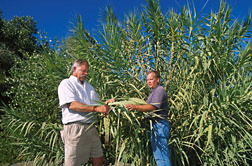Landowners Key to Controlling Giant Reed
This is Passport to Texas
Arundo donax, or giant reed, isn’t all bad. In some parts of the world it’s used as a biofuel, and even to make reeds for woodwinds. In Texas, where it covers a half million acres of land, it’s a pest. This non-native cane doesn’t provide food or nesting habitats for wildlife – but outcompetes native plants that do. Plus it disturbs aquatic ecosystems along riparian areas where it grows. TPW works with landowners in affected areas to manage the species.
These are private waters and landowners are able to come in and tell us what problems they’re seeing with the arundo, how it’s affecting them. They’re out there to monitor over time—let us know when they see native plants coming back, or if they see any re-sprouting popping up.
Monica McGarrity, with Texas Parks and Wildlife, says strategies used to manage the pest include: Pull. Kill. Plant. Pull up young plants, use EPA approved herbicides to kill mature plants, and repopulate with native vegetation. It’s worked in the Nueces River Basin.
So we’ve been working in the Nueces River Basin with the NRA for a number of years to manage arundo. And it’s been rather effective. There’s a huge partnership that includes landowners and a variety of techniques to manage the arundo and to replant some native plants. And now we’re able to expand this into the Pedernales Basin and into the Blanco River as well.
Monica McGarrity returns to talk about that tomorrow.
The Sport Fish Restoration program supports our series.
For Texas Parks and Wildlife, I’m Cecilia Nasti.



 Passport to Texas is a
Passport to Texas is a  Passport to Texas is made available by:
Passport to Texas is made available by: